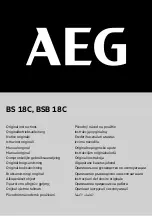
21
According to GE ED&C publication DET-034B entitled
C-2000
TM
Contactors &
Starters Technical Information
, the trip level dial on the contactors should be
set as follows.
Motors with Service Factor of 1.15 or Greater -
adjust OL relay dial to
the motor nameplate FLA
.
Motors with Service Factor Less than 1.15 -
adjust OL relay dial
according to the formula FLA times Service Factor times 0.90.
Example: 30 A motor with 1.00 service factor
Set OL dial at 30 x 0.90 = 27.0 A
If the overload relay dial is set correctly but trips in normal running situations
(indicated by the red “Motor Overload” light coming on), then your motor is
probably undersized for your load. Possible corrective actions are:
1.
Make sure there is not an unintended additional loading on the motor
resulting in the excessive current.
2.
Try another OL relay. Perhaps the tolerances on the one included with your
panel are unfavorable.
3.
Reduce the load on the motor. For variable torque loads when running on
the drive, this can be accomplished simply by slowly reducing speed until
the tripping stops. For bypass operation this would require a change to the
driven load.
If the overload relay dial is set correctly but tripping occurs on across-the-line
starts this is probably due to a large load inertia which results in high starting
current being applied for a longer time to accelerate the motor from a stopped
to full speed condition. Traditionally the problem of starting motors with high
inertia loads across the line has been solved by a number of methods falling
into the category of soft-starters. The AF 600 FP adjustable frequency drive is,
by its very nature, a “soft-starter” since it applies a very low voltage to the
motor when it is stopped and gradually increases to full voltage at full speed.
Recognizing that this problem can only occur during full voltage across-the-line
starts (in other words, starting in bypass mode), then possible corrective actions
are:
1.
Allow the OL to cool sufficiently between restarts. There is typically a 4 to 1
difference between the operation time of the OLs in their cold state versus
their warm state.
2.
Try another OL relay of the same rating. Tolerances on the OLs are loose,
trip times can vary significantly from unit to unit of the same rating (range
of 2 to 1 or more is not uncommon).
DEH40602
– Page 14
AN 11-2021 Rev 05, 12/15/2011
CAUTION:
For all AF 600 FP Bypass panels the overload relay dial should
never be set higher than the panel rated current even if allowed by the
above formula because the overload relay protects panel components such
as the contactors and line reactor in addition to the motor.
















































